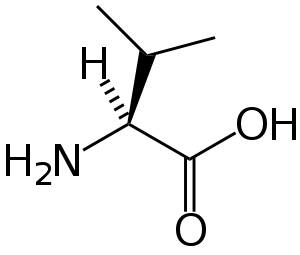Hypervalinemia
Hypervalinemia, is a rare autosomal recessive metabolic disorder in which urinary and serum levels of the branched-chain amino acid valine are elevated, without related elevation of the branched-chain amino acids leucine and isoleucine.[2][3] It is caused by a deficiency of the enzyme valine transaminase.[4]
| Hypervalinemia | |
|---|---|
| Other names | Valinemia or Valine transaminase deficiency[1] |
 | |
| Valine | |
| Symptoms | loss of apetite, vomiting, hypotonia, dehydration and failure to thrive. |
| Usual onset | 1-2 years |
Presentation
Presenting in infancy, symptoms include lack of appetite, vomiting, dehydration, hypotonia and failure to thrive.[5]
Genetics

Hypervalinemia is inherited in an autosomal recessive manner.[1] This means the defective gene responsible for the disorder is located on an autosome, and two copies of the defective gene (one inherited from each parent) are required in order to be born with the disorder. The parents of an individual with an autosomal recessive disorder both carry one copy of the defective gene, but usually do not experience any signs or symptoms of the disorder.
Diagnosis
Treatment
References
- Online Mendelian Inheritance in Man (OMIM): 277100
- Tada K, Wada Y, Arakawa T (1967). "Hypervalinemia. Its metabolic lesion and therapeutic approach". Am. J. Dis. Child. 113 (1): 64–67. doi:10.1001/archpedi.1967.02090160114013. PMID 6066688.
- Wada Y, Tada K, Minagawa A, Yoshida T, Morikawa T, Okamura T (1963). "Idiopathic hypervalinemia: probably a new entity of inborn error of valine metabolism". Tohoku J. Exp. Med. 81: 46–55. doi:10.1620/tjem.81.46. PMID 14077060.
- Dancis J, Hutzler J, Tada K, Wada Y, Morikawa T, Arakawa T (1967). "Hypervalinemia. A defect in valine transamination". Pediatrics. 39 (6): 813–817. PMID 6067402.
- "Valinemia | Genetic and Rare Diseases Information Center (GARD) – an NCATS Program". rarediseases.info.nih.gov. Retrieved 2018-04-17.